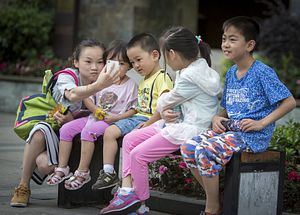China released a communiqué on Thursday that scraps its three-and-a-half-decade long social experiment known as the one-child policy. This announcement begins a new and unknown chapter in China’s determined and forceful family planning policy. According to the statement from Communist Party leaders in Beijing, all married couples will be afforded the opportunity to have a second child, if they choose. The shift in policy does not abolish the state’s control over the family, rather it is an attempt to remedy the problems ultimately magnified by the one-child policy. But China’s change to a two-child policy may prove ineffective at increasing population growth.
During the 20th century, the world experienced dramatic population growth, with the global head count passing one billion at the beginning of the century and reaching six billion in 1999. During this period, fears began to proliferate about the crippling consequences of a population boom: food shortages, rampant poverty, and environmental degradation. These worries led some policymakers to believe that the solution to population growth was population control.
Concerned about food grain shortages, China’s leaders following the death of Mao began to question the stability of the country’s population growth. These neo-Malthusian worries took hold in China and resulted in the one-child policy, the Communist Party’s answer to a ballooning population, allocating one birth per couple.
However, China’s population was already changing prior to the enforcement of the one-child policy in 1978. Some estimates have China’s urban and rural total fertility rate (TFR) dropping significantly around that time, with urban TFR decreasing from more than 6 children per woman in the mid 1960s, to more than 3 children per woman in 1970 and fewer than 2 children in the late 1970s.
Even with these previous trends, the one-child policy has been wildly successful in limiting births and lowering fertility rates. According to China’s family planners, the policy has prevented around 400 million births. In addition, by UN Population Division (UNPD) estimates, China’s TFR is roughly 1.55 births per woman – though this number is difficult to calculate given some parents hiding out-of-quota births. China’s coercive family planning policy arguably has accelerated the decline of China’s fertility rate.
While the one-child policy has done an impressive – maybe too much so – job of controlling population growth in China, the program has had considerable consequences, including a sex ratio imbalance, aging population, and declining workforce – all of which were foreseen and considered resolvable by the Communist Party.
Today, China confronts these demographic headwinds in full force. China’s cultural preferences for male heirs coupled with the proliferation of ultrasound technology has led to sex selective abortion throughout the country. As of China’s 2010 census, the sex ratio at birth was 118 baby boys for every 100 baby girls (when it is normally 103-105 boys per 100 girls), creating a growing army of millions of unmarriageable men who cannot find a partner. (They are known as “bare branches” in China.)
China’s population will grow old before it grows rich. With nearly 120 million people over the age of 65 as of 2010, China’s elderly population is projected to more than double to nearly 300 million by 2035. China’s population aging is occurring at the most rapid pace and greatest magnitude in the world, surpassing that of Japan. Yet China’s GDP per capita on a purchasing power parity basis is only a fraction of Japan’s, barely one third; and the traditional family network, which supported China’s elderly in the past, has attenuated and will struggle to support such a large group of elderly.
Population aging is made more acute by fewer births. Fewer babies means a small cohort of young adults in the future available to work in the world’s second largest economy – China’s working-age (15-64) group started to decline this year, according to UNPD estimates. As the primary source of labor, this age group is critical for economic growth and in China it is expected to fall 4.3 million per annum from 2015 to 2035.
The Communist Party population planners hope that adjusting the policy from one to two births per couple will resolve these problems. But these demographic problems are already baked into the cake. An increase in births, even if it occurs, would not ameliorate China’s problems for many years.
China’s planners may also find that redirecting the path of family development upwards is more difficult than expected, meaning the new family planning rule is unlikely to result in the desired outcome. Prior to the announcement of China’s nationwide two-child policy, family planners adjusted the policy in 2013, allowing couples to have a second child if one of the couple was an only child. Of the estimated 11 million couples eligible, fewer than 12 percent of couples went through the complicated application process for a second child (and not all of them will necessarily have another child).
The complete repudiation of China’s family planning policy may not shift the current family structure in China. To understand why, one need only look at sub-replacement fertility rates in surrounding East Asian countries. The decline of China’s total fertility rate is similar to that of other developed East Asian countries, such as Japan and South Korea, which have also experienced drops in fertility and are currently sub-replacement fertility countries, with TFRs of about 1.4 and 1.2 in 2010, respectively. These other Asian countries do not have a birth control policy.
China’s grand social experiment with population control has had the intended effect of squelching population growth. But it has also resulted in serious consequences, which are not as easily mitigated as the Communist Party believed at the time the policy was introduced in 1978. Continued state control over the family continues, albeit with a different quota. Now we must wait to see what this chapter of China’s massive social experiment will bring.
Alex Coblin is a Senior Research Associate at the American Enterprise Institute.
































